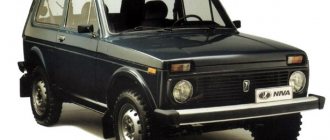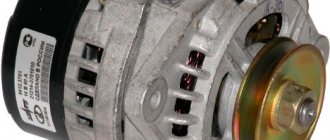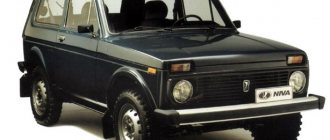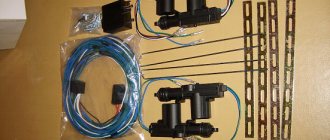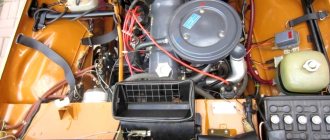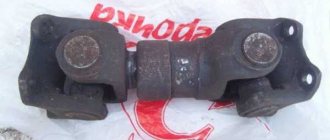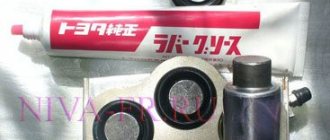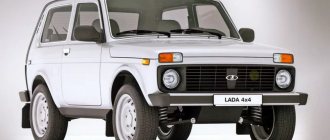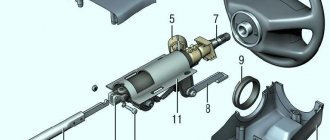The bottom is in good condition.
After the purchase I began to put it in order.
The first person who has driven a Niva will understand the disease.
The transfer case, gearbox, etc., everything nearby were also removed.
The village craftsmen rolled the threads on the studs under the box and transfer case.
after replacing oil seals, gaskets, broken bolts and nuts. The box and transfer case took their place.
Next, the suspension went into disarray. Everything was cracked, I replaced boots, springs, seals, ball and wheel bearings, shock absorbers. Steering rods. etc.
Well, I immediately decided to raise the slippers to 30.
Next, I shook up the entire ignition system. New coil, armor, switch, spark plugs, etc.
I even tried on 33rd wheels.
Price: 35,000 ₽ Mileage: 50,000 km
Lada 4x4 3D 2000 - do it yourself
Cars for sale
Lada 4×4 2121 Niva, 2019
Lada 4×4 2121 Niva, 2016
Lada 4×4 2121 Niva, 2014
Lada 4×4 2121 Niva, 1997
see also
Comments 19
thanks for the advice
Please help if you know. Why does my VAZ-2121 turn more to the right and less to the left? Maybe some lever lengths?
And while driving it doesn’t pull in any direction? And so, offhand, here we need to reduce the left steering lever by an equal length and increase the right one. In this case, the steering wheel should turn. Well, the steering gear itself, although its travel is limited by the travel of the rods. Something like this.
Please help if you know. Why does my VAZ-2121 turn more to the right and less to the left? Maybe some lever lengths?
The bipod of the steering column is not in the center. The treatment is as follows: you turn the steering wheel all the way to the left, counting, then to the right, then you find the middle. The middle is the straight position of the column. In this position, you adjust the steering rods so that the wheels are straight, the toe is 2-4 mm. After unscrew the steering wheel, move it according to movement, tighten it, that's it
Niva is the first development of AvtoVAZ, completed entirely independently. Niva is an all-wheel drive off-road passenger car. Its technical characteristics and design features (permanent all-wheel drive, significant ground clearance, small body overhangs) allow the vehicle to be used in addition to the paved road network also in off-road conditions and on terrain with complex surface topography. The car's outstanding all-terrain qualities have been repeatedly tested and confirmed. In all extreme situations, Niva behaves predictably, confidently and purposefully. Functionally, the Niva is quite suitable for transporting goods. With the rear seat folded down, trunk volume increases significantly.
VAZ-21213 and VAZ-21214 cars are comfortable, high-speed, compact, all-wheel drive off-road passenger cars designed for transporting passengers and cargo on roads with all types of surfaces and dirt roads. The cars combine the high cross-country ability of an all-terrain vehicle with all-wheel drive with the convenience, comfort, dynamics and speed qualities of a modern passenger car.
Compound
1. Headlight; 2. Front light; 3. Jack; 4. Radiator; 5. Windshield and headlight washer reservoir; 6. Engine; 7. Air filter; 8. Cooling system expansion tank; 9. Rechargeable battery; 10. Differential lock lever in the transfer case; 11. Gear shift lever; 12. Gear shift lever in the transfer case; 13. Steering wheel; 14. Front seat; 15. Rear seat; 16. Rear window washer reservoir; 17. Main muffler; 18. Rear bumper; 19. Rear brake; 20. Rear suspension spring; 21. Rear shock absorber; 22. Rear suspension transverse rod; 23. Longitudinal reaction rod of the rear suspension; 24. Fuel tank; 25. Rear axle; 26. Additional muffler; 27. Rear driveshaft; 28. Brake fluid reservoir; 29. Clutch fluid reservoir; 30. Transfer case; 31. Clutch pedal; 32. Brake pedal; 33. Front brake; 34. Front suspension spring; 35. Front axle; 36. Side turn signal; 37. Front bumper.
The engine, clutch housing and gearbox are interconnected and form a power unit, which is mounted on the car at three points on rubber cushions.
The engine is a four-stroke, carburetor, in-line, with an overhead camshaft. Compared to the VAZ-2121, the engine power has been increased, making it better able to adapt to load changes.
Technical characteristics of the VAZ 2123 engine
The VAZ 2123 power unit has a working volume of 1690 cubic meters. cm. It is naturally aspirated and runs on gasoline fuel. His weight is 127 kilograms. The electronic fuel injection system increased engine power to 80 hp, and the torque is 127 NxM, which becomes available at around 4000 rpm.
On the highway the car can reach a speed of 140 km/h. A five-speed manual gearbox is responsible for shifting gears. Highway consumption does not exceed 8.5 liters per 100 km. In the city it increases to 14 liters per 100 kilometers. In such an engine, for its stable operation and responsive traction, it is recommended to fill AI-95 gasoline.
Basic systems
Engine lubrication system – with full-flow oil filter.
The cooling system is liquid, closed type. The system includes a body heater, which receives fluid from the cylinder head and is discharged to the pump. The coolant is a special one with a low freezing point and a high boiling point. The radiator is aluminum with better heat transfer characteristics and is more technologically advanced than the brass radiator of the VAZ-2121.
The power system includes an air filter, fuel tank, fuel pump and carburetor. The fuel tank is located under the rear seat. The carburetor is equipped with a high-efficiency dry-type air filter with a paper filter element.
The carburetor is installed as a “Solex” type, similar to that used on VAZ 2108 - 2109 cars. This carburetor, in combination with a contactless ignition system, reduces fuel consumption.
Air intake
Modern engines on the Chevrolet Niva are equipped with a new air intake system, which is characterized by an increased volume of the air filter. Design changes also affected such details as:
- Inlet pipe with pipes;
- Receiver;
- The throttle type has replaced it.
The entire electronic system works thanks to a controller which can be the following:
Thanks to the improved injection control system, which has a pair-parallel design, it becomes possible to control fuel consumption. The injectors in the fuel rail are installed "SIEMENS" type. In order to protect the engine, a special plastic casing is installed.
Transmission
The clutch is a single-plate, dry clutch with a diaphragm pressure spring and a hydraulic release drive. Gearbox – mechanical, three-way, five-speed. The transfer case is a two-stage three-shaft with an interaxle lockable bevel two-satellite differential.
The intermediate driveshaft connecting the gearbox to the transfer case has an elastic coupling and a constant-velocity universal joint. The cardan shafts of the rear and front axles at the ends with cardan joints on needle bearings with grease fittings transmit torque from the transfer case to the main gears of the axles.
The main gears of the front and rear axles consist of a pair of bevel gears with spiral teeth of hypoid engagement. Differentials - conical two-satellite.
What kind of Shniva is it without protection... — logbook of the 2012 Chevrolet Niva PILIGRIM on DRIVE2
The door seals are thicker, and optional roof rails are available, as are body-colored door handles and mirrors. We revised the sound insulation and the design of the wheel rims. Chevy Niva is one of the few cars on the Russian market that does not have an airbag in the basic version.
However, starting with the GL configuration, both the driver and front passenger have it, and they also have belt pretensioners. The only active safety system is ABS. The parts are very simple in shape - it will not be difficult to edit.
Improving
A well-thought-out and laconic fastening system - to standard places using a pair of durable steel beams. Reliable mortgages, with intermediate galvanized washers.
Ground clearance is reduced by only 15 mm. I see only one minus, and some Chevrolet Niva owners agree with me - the nuts of the axles of the lower arms of the front suspension remain open.
This is because the protection is relatively narrow. The rear view mirror noticeably distorts the view, but no longer vibrates, since now it is not attached to the body, as before, but is glued to the glass. The interior mirror has also been replaced. I just wonder why such a small thing could not have been done earlier? The knobs of the gearbox and transfer case levers are also new.
They look stylish and fit comfortably in the hand. But why does the transfer case lever knob rotate freely around its axis?
Electrical equipment
The electrical equipment of cars is made according to a single-wire circuit, in which the negative terminals of sources and consumers of electricity are connected to ground, which serves as the second wire. The current sources in the system are an alternating current generator with a built-in semiconductor rectifier and a microelectronic voltage regulator and a 6ST-55 lead-acid battery. To start the engine, a starter 35.3708 is used.
Read also: Time for regular maintenance 45 volvo xc90
Malfunctions
The main reasons why the engine on a Chevrolet Niva may not start may be as follows:
- The fuel line is dirty. The problem can be solved by regular blowing or flushing;
- The filter installed between the engine and the fuel supply pipe is clogged;
- The fuel supply system does not have the required pressure. It is necessary to check the condition of the pump;
- At idle there are problems with the control device;
- Air has entered the fuel supply hoses;
- There are problems with the throttle valve or its sensor;
- The ignition system is faulty.
Body
The car body is of a supporting structure, three-door, all-metal. The body shell is a welded structure assembled from panels, side members, cross members, struts and various reinforcements.
Side doors with a front hinge have two safety glasses: the front one is rotating with a handle and a lock, the rear one is sliding glass driven by the window lifter handle. The tailgate is hung on the body on two hinges and is locked with a lock. The door is held in the open position by gas-filled stops. The rear door sill is lowered to the level of the bumpers, making it easier to load and unload cargo.
Window and rear windows with panoramic glass. The windshield is polished, three-layer, and the back and sides are hardened.
The front seats are separate with reclining backrests and have a mechanism for adjusting the seat position and backrest tilt. The rear seat is common, folding to form a cargo area.
The VAZ-21214 differs from the VAZ-21213 by installing an engine with a fuel injection system. This system ensures compliance with 1983 US emissions regulations and also improves vehicle performance. Changes to the engine concern the power supply system, ignition and exhaust gases. Features of the fuel injection system are described in section Fuel injection 21214.
Due to the use of complex technological equipment and the need for high-quality work, it is recommended that the treatment of hidden cavities be performed only at car service stations.
The procedure for performing operations to protect hidden cavities from corrosion:
- place the car on a lift, remove parts and upholstery that prevent access to hidden cavities;
- rinse with water at a temperature of 40-50°C through the technological and drainage holes, hidden cavities (Table 8-2) and the bottom of the body until clean water flows out. In this case, the sliding windows of the doors must be raised;
- remove moisture that has entered the passenger compartment and luggage compartment, blow with compressed air all areas where the anti-corrosion compound was applied;
- Drive the car into the chamber for applying the anti-corrosion compound and place it on a lift. Spray anti-corrosion compound to the areas shown in Fig. 8-6, 8-7 and 8-8;
- lower the car from the lift, clean the front surfaces of the body from dirt with a rag soaked in white spirit.
Rice. 8-6. Hidden cavities (front view of body):
1 — upper cross member of the front end; 2 — headlight housings; 3 — lower cross member of the front end; 4 — under the front wing; 5 — external threshold; 6 - internal threshold.
Rice. 8-7. Hidden cavities (rear view of the body):
1 — rear side members; 2 - between the rear wheel arches and the sidewalls; 3 — rear side members; 4 — rear floor cross members; 5 — central pillars; 6 — front door pillars; 7 - door pocket.
Rice. 8-8. Hidden cavities (body view from below):
1 — front side members; 2 — connectors of the front side members; 3 — middle spars; 4 — connectors for middle side members; 5 — cross members of the rear floor; 6 — rear side members; 7 — rear cross members.
Looking back at the year of my life completely spent on the Niva, I remember what was done and what should have been done differently... And some things, probably, we did in vain...
I DON'T HAVE TO DO IT AS BEST, DO IT AS WELL!
Lada 4x4, VAZ-21214, as well as all other SUVs that we historically call “Niva”, have several obvious advantages and no less obvious disadvantages, most of which are revealed only during operation. For some time now, the main advantage of the Niva has been its price. Let me remind you that this was not always the case and, for example, in Soviet times, a VAZ-2121 cost 9,900 rubles, only slightly inferior to the Volga in this indicator. In fact, it was the only versatile SUV on the market. LuAZ was completely utilitarian, and buying a UAZ for private ownership was extremely difficult, that is, almost impossible. At the same time, if we remember that a Zhiguli, say, the fifth model, cost 5,300, then it becomes clear why there were no queues for the Niva. In the late eighties, the VAZ-2121 was even sold in installments (as, by the way, was the Moskvich). Now try to find a Niva of that time in decent condition! And especially in determining this decent condition is the body. This is the first thing I strongly recommend that a young man who is planning to buy a VAZ SUV pay attention to. And I don’t even mean the presence of rust, the strength of the side members and other strength elements, but the mandatory and indispensable anti-corrosion treatment. Even if the body is strong and the “red plague” is not visible, believe me, half of the winter it will appear even in a five-year-old car. The body of the Niva is load-bearing - that is, each element is, in fact, a force-bearing one. Any corrosion, especially advanced corrosion, especially through corrosion, plus vibration, plus loads when driving off-road - and then only expensive body repairs with reinforcement, welding, aluminum linings and scary-looking “extenders” of wheel arches. So, the first stage is anti-corrosion. You may ask, is it worth filling your car with popular and varied protective coatings? Yes, if you have money and the first stage is completed perfectly. This is beautiful, practical and well complements the preservation of the body, since the paintwork scratches easily and blooms instantly (you can read about a similar experience with our Niva and Titan in issue No. 12/2016 of our magazine).
Just step on the gas a little and damage is inevitable.
THE NIVA'S BODY IS SUPPORTING - THAT IS, EVERY ELEMENT IS, IN ESSENCE, POWER-BASED
The second thing to do is replace the main pairs. Even if you spend most of your time on the pavement, you may need a little more traction on one of your longer trips. For example, somewhere in the mountains or foothills. You press the gas, press it some more - it seems to be going, acceleration, impact... the cardan splits in half, the journey is over. You won't get far with front-wheel drive. And if you took your time, carefully, then perhaps you would see not a picture of a broken cardan, but the Lago-Naki plateau. Which specific pairs are needed depends on the circumstances: universal 4.1, if the wheels remain within 28 inches, starting from 29 and larger - 4.3. It is important to remember that it is not only the search for quality parts that causes difficulties, but also their installation. If possible, take assembled gearboxes. Better than the Soviet ones. They are found at showdowns and in “penny for spare parts” advertisements. It’s even better to supplement the traction main pairs with a tuning kit for the transfer case with a lower 2.95. But such a reduction will require the driver to think more with his head than to work with the pedal, since axle shafts and CV joints are also not eternal.
Now only expensive body repairs with reinforcement and welding will help
YOU DON'T NEED UNLOADED HALF AXLES, NIVA IS NOT A TRUCK
Strengthening the chassis - part three. You most likely do not need unloaded rear axle shafts. This is the prerogative of trucks with a large workload. Finding high-quality “reinforced” ones is also not easy. They complain about all manufacturers, but, in principle, forward - non-adjustable hubs with sealed bearings “like Iveco”, back - axle shafts, say, from Izhevsk. Of course, no one bothers to tighten the hub bearings every 30-40 thousand kilometers, however, after driving through fords, muddy ruts and puddles, we can face the rapid death of the mentioned bearings literally within a couple of hundred kilometers on the highway. Behind the general noise of the Niva, the roar of the transmission and the howl of mud tires, the sound of wear may not be noticed, and you will immediately get a replacement. Non-adjustable hubs are sealed, this is their main advantage. As for the rear axle shafts, it is a matter of faith that this will help. But it’s definitely worth strengthening the bridge. Especially on a long Niva, heavy load or gas equipment. Sometimes the bridge bends when driving onto a curb unsuccessfully, not to mention off-road use and expeditionary conditions, when the load on the car is maximum. Even a bend invisible to the eye can lead to permanent problems with axle shafts and gearboxes. Hypothetically, you can check the axle on a wheel alignment stand, or you can “clear it” by removing the axle shafts.
Read also: Hyundai Accent Tagaz paint code
EXPERIENCED NIVA GROWERS SAY THAT NIVA IS GOOD IN STOCK, BUT ELEVATOR IS EVIL
The elevator is another popular reason for battles. Opinions are polar! We made a 40 mm lift, lengthened the bump stops and did not notice any negative consequences. Yes, maybe 8 cm spacers and springs from a Chevrolet Suburban are too much, but 40 mm is what you need. What's the point, you ask? Increased ground clearance in the base. For a long car this is critical. The maximum wheels that can be installed without cutting the arches are 215/75 R15, or, as in our case, 215/65 R16. More - cutting or lifting will be required, and more often both. Cutting arches is another stumbling block for Niv owners. But everything is simple here: if you are not going to resell the car for maximum profit, you are not going to install wheels larger than the ones above, then you don’t need cutting. But starting from 225/75 R16 or 235/75 R15, it is better to shorten the arches. At the same time, it is important that at the back, where the panels go end-to-end, there is not just sealant, but riveting or welding with the obligatory anti-corrosion agent.
Do you have to change rear axle bearings often? Check if the bridge is bent
We change the hubs to non-adjustable ones
It is very useful to install underbody protection. It is not necessary to “ski” from the bumper to the rear axle, but it is better to cover the engine compartment, transmission and, if you drive on rocks, the transfer case. We chose a light alloy, but steel will be cheaper. It is important to pay attention to ensure that dirt does not accumulate on the protection, which can significantly impair the cooling of units in the summer. What I categorically do not recommend doing is hanging the Niva with iron. Power bumpers, sills, an expeditionary trunk, a ladder, a bracket for a spare wheel, a mount for a canister, a jack, a shovel and sand trucks - that's an extra 200 kg for your car. And yet, even if you replace the generator, you should not abuse additional light. Fog lights, work lights, reverse gear - that's all. Needless to say, preference should be given to LED lights. In addition, I recommend replacing the standard headlights with sealed ones, they are available for sale. And you definitely shouldn’t mess around with xenon.
EVEN ON A SHORT “NIVA” YOU CAN PAINLESSLY INSTALL GAS EQUIPMENT
Of particular interest was the installation of gas equipment. We listed detailed pros and cons in the material on this topic (can be found on the website or in free archived issues on the App Store or Play Market). There were more advantages. A year and a half of operation confirms our conclusions. A kilometer of run is almost half the price, and the installation paid for itself a long time ago. Even a short Niva can be equipped with gas if you remove the cylinder under the bottom and protect it from behind with a tow bar. After the lift, there is almost 350 mm of ground clearance under the cylinder, and this does not interfere with off-road conditions. It is clear that if you are taking a car for sports, then it is better not to do this - in such a situation, every kilogram counts.
The Niva doesn’t need unloaded axle shafts, but reinforced ones won’t hurt
Wheels with a diameter greater than 29 inches require both a lift and arch cutting
CHIP TUNING IS USEFUL, BUT IT'S ALWAYS A COMPROMISE
Many Niva owners doubt the need for chip tuning and boosting the engine. I can’t recommend boring the block to 2.0 liters, but I fully approve of the low-level camshaft, the corresponding engine control program and the 4-2-1 exhaust manifold. Carburetor cars, in addition to the shaft and exhaust, definitely need to look for more high-torque main pairs. As for our Niva, I was quite satisfied with the chip tuning. And even though the car didn’t fly, it crawled much more confidently. By the way, the purchase of a snorkel can be timed to coincide with the work on the engine, and the installation of the protection units can be accompanied by the removal of unit breathers. Yes, and no one has canceled the snorkel from sanitary products yet. If you don’t want to cut the hood or fender, buy a corrugation from Priora and replace the standard pipe by bending the corrugation up towards the hood - you’ll get an additional thirty centimeters of fording depth for a hundred rubles. If funds allow, it is worth moving the generator higher, replacing it with a more modern and powerful one. The spare tire, however, will have to be removed from under the hood, say, onto the top trunk.
I wanted to write about the salon, but stopped in time... I will limit myself to only recommending replacing the seats with foreign ones. In general, for any, the main thing is to get rid of the factory ones! Believe me, you won't regret it! And in general, I must admit, “Niva” provides amazing scope for creativity, not limited by anything other than technical regulations and budget. The main thing is not to forget that the best is sometimes the enemy of the good!
Even a short Niva can be equipped with gas if you remove the cylinder under the bottom and protect it from behind with a towbar
This car was able to change the idea of what a compact all-terrain vehicle should look like not only among residents of the Soviet Union, but also among the countries of the Western world. Luck has accompanied the domestic car since its creation and still guides it along the path of world history, reinforcing the treasury of achievements with new victories.
The history of the VAZ 2121 begins in 1972. At the same time, thoughts about an affordable all-terrain vehicle for citizens of the USSR appeared among the country's leadership since the late 1960s. The Soviet Union urgently needed a “rogue” that was accessible to the vast majority of the population and had excellent performance both on and off the pavement.
This desire was caused by the fact that the road network of the USSR was in an underdeveloped state, and the quality of the roads themselves left much to be desired. And, in 1970, by decree of Alexei Kosygin, a tender was created for the construction of a machine that meets the necessary requirements. The development of the all-terrain vehicle was carried out by three manufacturers at once - AZLK, IzhMash, AvtoVAZ. The latter was able to present the most interesting version of the future Niva.
Read also: The difference between oil and gas-oil shock absorbers
Lada 4×4 was created on a radically new platform, which had not previously been used either at AvtoVAZ or anywhere else. For its time, the all-terrain vehicle had revolutionary technical characteristics and became a vivid embodiment of progress in the global automotive industry. In particular, all-wheel drive was permanent, the suspension was made independent, and the body was made load-bearing. All this was supported by an attractive design, as well as a comfortable interior.
Lada Niva underwent sea trials in the Ural Mountains and in the vast expanses of Central Asia. It is noteworthy that the SUV passed all the necessary tests quite well. However, compared to the more serious Land Rover and UAZ, it turned out that the new product feels very confident when driving on bumpy terrain, while difficult long sections are less easy for the car.
In 1975, a decree was signed to put the new Lada on the assembly line. In 1976, the first batches of cars rolled off it. Full-scale production of the model began in 1977.
An interesting fact is that the vast majority of VAZ 2121 produced were exported to other countries from the first years of production (up to 80 percent of the total volume of cars produced were supplied to foreign markets). At the same time, in the USSR itself, all-terrain vehicles remained in short supply for some time. The model was in high demand in Germany, Great Britain, the Benelux countries, and Japan.
For foreigners, the Lada Niva has become the standard of an affordable SUV that can be safely used in a variety of conditions.
Civil (main) modifications for the countries of the USSR/RF and the CIS:
- 21211. This car was equipped with a 1.3 liter engine that produced 69 horsepower.
- 2121. The main modification of the all-terrain vehicle until 1993. It features a 1.6-liter power plant with a capacity of 80 horsepower.
- 21213 "Taiga". Restyled version of the Niva (since 1993). It features different rear lighting optics and an updated interior. A modernized 1.7 liter engine is installed, producing 83 horsepower. The latter is combined with a five-speed manual transmission.
- 21214. A 1.7 liter power unit with a fuel injection system is installed (since 2002). The car meets European environmental standards.
Special variations intended for civilian use:
- Lada 4×4 “Lynx”. The factory tuning version of the domestic all-terrain vehicle debuted in 2009. This model differs from the standard version by extended wheel arches and larger side-view mirrors. The main feature is the screw-type self-locking differentials installed on the front and rear axles.
- Lada 4×4 Urban. This crossover entered the market in 2014. The exterior is notable for its different radiator grille, bumpers, rear pillar trims and unique color scheme. The Urbana salon received a new steering wheel, air conditioning system, electric windows and side mirrors.
Niva bottom view photo
Do you think the legendary Lada Niva is one and only of its kind? No matter how it is - we have scraped together at least a dozen of its modifications that you may have never heard of!
VAZ 21212: from left to right
What is this, Barrymore? Zis from Zevery English "Niva", sir. This is the same case when the mice injected themselves, cried, but continued to eat the cactus. That is, there were a ton of complaints about this Soviet SUV, but its simplicity, cheapness and maintainability propelled the popularity of this miracle into the stratosphere. The right-handed Niva was also supplied to Japan. Just shhh, don’t tell anyone about this!
VAZ 2122.600 “River”: Sushi oars…
Jokes aside, in the late seventies, the USSR defense industry almost adopted such an amphibian based on the Niva into service. The “River” had a body sealed from below and a canvas roof. In 1987, the prototype even passed certification tests, but something went wrong - the car did not make it onto the assembly line and was not put into service.
VAZ-21215: nowhere heavier
Russia's friendship with France is not just about Depardieu with our passport. This is also a Niva with a good diesel engine from Peugeot, model XUD 9SD. The circulation of the heavy-fuel SUV was limited, but the modification was produced for a long time - from 1999 to 2008. By the way, in addition to the tractor engine, the diesel Niva was distinguished by goodies such as decorative overlays and even a kangaroo guard.
VAZ 2121F: the van will move...
Pourquois wouldn't mind, actually? The option, naturally, is purely for export, like many other varieties of Niva. As for the technology, everything is simple: two seats in the front, an all-metal van in the back. The hold had special guides for securing cargo, and no decorative trim.
VAZ 21218 Handicap: show-off bolts
The proletarian VAZ-2121 is like a mongrel without a collar: no posture, no pedigree, a farmer’s dream, but nothing more. “Fora,” on the other hand, is a purebred shepherd bred from who knows who. The guys from PSA BRONTO in the mid-90s made a luxury version of the Niva with enlarged wheel arches, large alloy wheels, a wider sofa from the V8 in the back, the roof had a plastic superstructure, and for an additional fee the car could be equipped with power steering and even air conditioning!
VAZ 212182 Force: battleship “Potemkin”
The same “Handicap”, only from the side. I mean, armored. Version for collectors. The body added a total of 430 kilos, which is why the suspension had to be strengthened. The chassis received reinforced shock absorbers and thick springs. The armored car also had an automatic fire extinguishing system installed under the hood, as well as a protected fuel tank, a reinforced battery and air conditioning. For an additional fee, specialists could install armor on the belly of the SUV.
VAZ-212183 Landole: complete surreal
This variety of “Niva” was supposed to be a belated answer to the Jeep Wrangler, but something tells us that the Americans had never heard of such a threat to the “Wrangler”... Laugh with laughter, but the model is produced to this day in a very limited edition at the PSA BRONTO enterprise " In-house tailoring, so to speak. Instead of the upper part of the body, the Landol has a power safety cage, which, if necessary, can be covered with a tarpaulin. There are no doors, the tailgate folds down, the interior can be washed with a garden hose - the seats are in leatherette, the floor is linoleum.
VAZ 2131: crocodile tears
One of the most popular versions of the SUV. The craftsmen at VAZ simply welded a half-meter insert into the classic Niva. A variety of assortments from the “Russian Style” series. The car received the corresponding name among the people – “crocodile”. Despite the worse off-road characteristics, increased weight and terrible dynamics, the car is still damn popular in the Russian outback.
VAZ 2329: Pick it up
And then Ostap got carried away... The four-seater pickup truck based on the crocodile had a wheelbase of 2700 mm, a load capacity of 650 kilos, and the rear overhang was increased by 300 mm. Contrary to common sense, this miracle turned out to be quite popular in our market. Among the features worth noting are the original second-row sofa, which folds into the floor, and an additional fuel tank (the pickup’s total gasoline reserve is 84 liters).
Owner reviews: what are the pros and cons of the model?
VAZ 2121 is deeply loved all over the world. Legends are made about this car and it is cultivated. Practice has shown that the Russian all-terrain vehicle has a reliable chassis that can withstand extreme use on a wide variety of roads and terrain.
In addition, the model’s high maintainability is also valued - some components and assemblies can be repaired literally in an open field. A minimum of electronic systems guarantee trouble-free operation of the vehicle in harsh climates.
The disadvantages include the low resistance of the body to corrosion. And yet, many criticize the Niva for its mediocre acoustic comfort, which makes long trips on it unbearable. The owners are trying in every possible way to improve this design flaw and install additional sound insulation. Detailed information about this is presented in numerous articles and videos on the Internet.
Welding work
The first step is to remove rusty metal and corrosion. It is advisable to carry out this work with a grinder. Hard-to-reach places are cleaned using a gas welding machine. Then the metal patches are cut out. This is done with special scissors. This way you can make correct, even workpieces without torn edges.
It will be easier for two people to weld a new floor, since you will have to fix the patch and weld it at the same time. Basic rules for welding the bottom:
- The patch is stuck at 3-4 points, and then completely scalded.
- Short sutures are used to correct small defects. Length – 3 cm.
- The patch is applied as tightly as possible. In gaps, corrosion quickly forms again.
- To increase the strength of the seams, they are hammered.
Market price
Under the USSR, the average cost of a domestic all-terrain vehicle was nine thousand rubles. At the moment, the car is already obsolete.
However, it is still considered one of the most expensive in the AvtoVAZ line:
| Auto | State | Price (rubles) |
| VAZ 2121 | new | from 480 thousand |
| VAZ 2121 | boo | from 45 thousand |
Bottom repair without welding
Niva flooring can be repaired without a welding machine. This is done in two ways:
- Installing a sheet metal patch. Rivets are used to secure them.
- Application of composite materials. They contain polymer resins, reinforcing filling and a curing reaction accelerator. This material restores the mechanical strength of the area and reduces the risk of rapid rust.
Installing patches is suitable for large-scale damage. If corrosion has pinpointed the bottom, it is easier to seal the hole in the Niva with a special mixture.
Test Drive
Timeless motives
At the time it went on sale, Lada Niva was one of the most beautiful cars of its time. Now square body shapes, round lighting optics and laconic bumpers are already classics that evoke a feeling of pleasant nostalgia.
However, the creators calculated everything perfectly. Short body overhangs and non-protruding bumpers provide outstanding geometric cross-country ability. A minimum of plastic parts reduces the risk of damage during extreme use, and the ground clearance of 220 millimeters makes it possible to navigate deep ruts and mountainous terrain.
Nothing extra
The interior is simple but functional. The instrument panel with analog scales and a tachometer is perfectly readable due to large digitization, and is also quite informative. On the center console there is a climate system unit in the form of sliders, as well as control keys for light and rear window heating - they are organized compactly and there are no problems with their use. Ergonomic miscalculations include a pedal assembly shifted to the right, as well as a significant distance to the manual transmission lever.
The front seats have no profile. However, they are comfortable to sit on due to optimal rigidity and the presence of lateral support rollers. But the back seat is cramped in all directions, even with a height of 165 centimeters. The initial volume of the luggage compartment is 265 millimeters. When the second row seats are folded, the figure increases to 585 liters.
Subspecialist
You can drive the VAZ 2121 quite confidently on an asphalt highway. The 1.7-liter fuel-injected engine (83 horsepower) pulls confidently at low and medium speeds, and the optimally selected transmission ratio makes it possible to accelerate well at speeds of up to 70 kilometers per hour. At the same time, the clarity of gear shifts is mediocre, and the moves of the manual gearbox lever are very sweeping.
The steering with low sensitivity is not very informative, and the steering wheel itself rotates with noticeable effort. The latter causes discomfort when maneuvering in city conditions. At high speeds, the car yaws along the road, as well as significant rocking.
The main disadvantages of driving comfort are vibrations and annoying hum from the engine and transmission. Also, above 80 kilometers per hour, aerodynamic noise begins to appear, which forces you to seriously raise your tone when communicating with the rest of the occupants of the cabin. In a word, lovers of long-distance travel will not be delighted with the VAZ 2121.
But everything changes - you just have to drive onto a country road. Having felt its native elements, the Niva begins to surprise the driver with an energy-intensive suspension that provides excellent ride comfort, as well as absolute immunity to road irregularities. At the same time, the transfer transmission coupled with all-wheel drive allows you to successfully get out of sticky mud, clay or sand.
Device under the bottom (bottom view) Niva Chevrolet - Niva Chevrolet (VAZ, Chevy)
According to the manufacturers, there is simply no point in comparing the first and second line of Chevrolet Niva cars, because the first family is seriously behind in all criteria.
Treating the underbody of a car against corrosion - Chevrolet Niva
In general, it is quite possible to make the protection yourself, especially since there are a lot of patterns on the Internet - you can make the thickness of the material yourself, what thickness you need and choose the material itself. Therefore, VAZ decided not to waste time on projects right away, but to focus on releasing the model
You are here: Chevrolet Niva" 1st generation (year of manufacture)" Articles and reviews" Protecting the Chevrolet Niva from below. In a word...
But once I drove onto a stump, it’s good that I sat on it sideways. Only a Karcher can help out - the jet power is enough.
In addition, the rear of the car includes a large tailgate, protective body kits, powerful glass in the tailgate, elegant dimensions and a spare wheel that is attached to the trunk. Well, the third option for protection material is some kind of composite. If you want your armor to be strong, put 10 mm duralumin on the bottom - then it will be able to withstand the weight of the car and will not bend. But for the money, it turns out quite well.
Under the hood, engineers installed power unit 1. Traction on two axles was realized through a 5-speed manual gearbox.
The FAM-1's equipment list included two front airbags, ABS, air conditioning, driver's seat height adjustment, and front seat belt pretensioners. Unfortunately, meeting such a car on the road is a great success, so you can often learn about it from a few articles and videos on the Internet.
Update This year, the Chevrolet Niva underwent a modernization procedure. That’s why, when doing off-road tuning, many people install special protection that covers all the important components.
The crankcase protection - I don’t know, as for me, the standard one copes with its function perfectly, the iron there is thick, I didn’t measure it exactly, but it doesn’t bend with your hands at all.
This protection has already saved me a couple of times, when I dived headfirst into a hole, and at the bottom of the hole there was a stump. It was in this that I poked the protection, which withstood a really small blow and protected the engine. And it didn’t even bend, maybe I got some kind of hardened one. The only thing that bothers me is the fairly large holes into which dirt instantly gets stuffed, then it hardens there and turns into stone.
It becomes very problematic to knock it out from there. Only a Karcher can help out - the jet power is enough. What are these holes for, some may ask? I will answer - for ventilation of the engine, for cooling it, if you want. There is a bright backlight that stands out on the finishing plastic of a dark background. The steering wheel is plump and has 3 spokes with chrome elements.
Interestingly, journalists learned from company representatives that the seats in the car will be more comfortable than those on the concept, and noise insulation will be increased. The driving position is quite high and visibility is excellent. As another plus, the designers have improved steering response. Due to the fact that the doorways have become more spacious, boarding and disembarking passengers has become more comfortable.
In expensive trim levels, the interior and seats will be upholstered in genuine leather, while the basic trim level will feature high-quality fabric. The seats installed in front received lateral support and massive headrests.
In terms of interior volume, it is the same, which means that passengers will be able to sit comfortably in the seats and not experience discomfort. It’s nice that the luggage compartment has grown, which allows you to transport luggage or large cargo.
Chevrolet Niva car Now its volume is liters, and if necessary, it can be increased by folding the seats, which will result in liters of usable space. Inside the Chevrolet Niva, all elements are made of plastic, which is pleasant to the touch.
anti-corrosion treatment Niva Chevrolet
If you look at the center console, you cannot say that the car was made in the Russian Federation. Oversized drivers have loose seats. The front panel may become deformed when exposed to direct sunlight, especially the glove compartment lid; it simply stops closing. Cold air can blow through torn boots of the gearbox and transfer case levers, and water can seep through the steering shaft seal and antenna mount.
FakeHeader
This year the car was seriously modernized. The update was led by the Italian design studio Bertone, so the restyling affected the appearance of the car and the interior decoration.
The radiator grille has changed, new lensed headlights have appeared, and the lights have acquired a different pattern, the bumpers have changed, and the rear one received a convenient rubber pad that makes it easier to load large cargo.
The interior now has a different steering wheel with three spokes and a more comfortable gear knob, an open box and two cup holders between the seats, different seats and a better quality headliner. Finally we made normal lamp shades and an eyeglass case.

